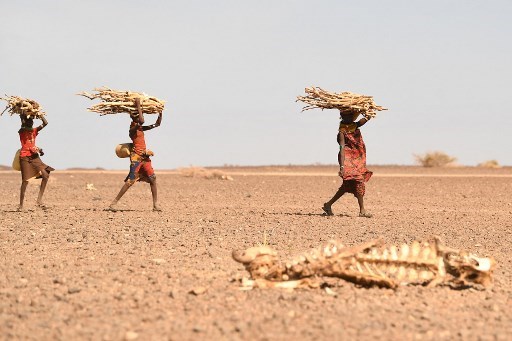
Friday September 2, 2022

Visiting one of the villages in Laisamis, northern Kenya, 85-year-old Ntaingon is merely surviving. She told Xinhua she cannot remember when she last experienced rainfall, saying this is the worst drought she has ever experienced.
Kenya's National Drought Management Authority (NDMA) has reported that 4.1 million people are food insecure in the arid and semi-arid parts of Kenya.
About 11 counties in the northern part of the country are acutely affected with Marsabit being the worst hit.
Mustafa Parkolo, the Marsabit NDMA coordinator, told Xinhua that Marsabit has been put under emergency phase following four seasons of failed rainfall. This has adversely affected socio-economic production.
"The last time we received rain in Marsabitv was the short rains of March, April, May 2020, so up to this time we have not had any rains and that is about 4 seasons translating to two years and the projections indicate that the rains we are expecting in October, November, December will also perform below normal, meaning we will have 5 seasons, two years and three months of failure of the rains", said Mustafa.
As a result 226,800 people now require humanitarian assistance, said Mustafa.
As one drives around Marsabit, there is evidence of the hard-hitting drought with carcasses of livestock strewn in different parts. The community here depends on pastoralism for a livelihood and yet according to NDMA they have lost more than 272,000 heads of livestock recently.
Lekuton, a Samburu herder, told Xinhua he had walked for three days from his home in Karare in search of water for his livestock. He has lost about 50 cows and is now left with only 20 with two threatening to die of hunger as they are severely emaciated.
Lekuton is not alone, the young warriors of this community popularly known as Morans, trek for days in search of pasture and water to salvage their main source of income and food for their livestock, never mind that they too face starvation.
For the Pastoralist community, their livestock is somewhat sacred to them.
Laisamis, one of the most affected areas in Marsabit County, has got 2,000 households according to the local area chief Augustin Kumi.
He said there are quite a good number of people who don't get food and cannot support themselves. He added almost half of the households in this location don't get good diets because of abject poverty.
The school-going children have also been greatly affected as they have to walk for several kilometers to attend school.
Adan Mburu, the headteacher at Silapani Primary school, said that before the drought, the school had a feeding program which was an incentive for the children to attend school, but since the supplies have run out, the attendance has dropped drastically.
"Most of our learners here come from a far distance around 5 kilometers, some six kilometers, and they get difficulties when coming to school, usually going back is also a problem, they are getting difficulties on the way, especially the young ones like some feel thirsty, they are not able to reach the village if they don't carry water", Said Adan.
Recently only about half of the school's population attends school regularly.
Ntamatin Khoyan, a mother of six including 4 girls and 2 boys, told Xinhua that most nights her children go to bed hungry. Some are too weak to go to school the following day because even breakfast is a challenge at times.
Though the government through NDMA has offered food relief and a cash transfer of 55 U.S. dollars every two months to households, reports show more needs to be done.
The drought has not hit Kenya only, the neighboring Somalia faces a more severe situation with 7.1 million people on the brink of starvation.
The UN agencies have warned that severe hunger is sliding towards famine. The World Food Program has reported that up to 22 million people in Ethiopia, Kenya, and Somalia are facing severe hunger.